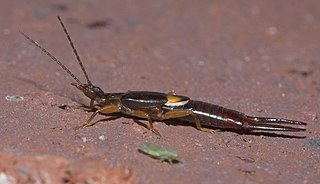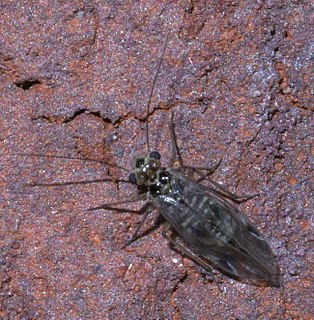
Earwigs make up the insect order Dermaptera. With about 2,000 species in 12 families, they are one of the smaller insect orders. Earwigs have characteristic cerci, a pair of forceps-like pincers on their abdomen, and membranous wings folded underneath short, rarely used forewings, hence the scientific order name, "skin wings". Some groups are tiny parasites on mammals and lack the typical pincers. Earwigs are found on all continents except Antarctica.

Forficula auricularia, the common earwig or European earwig, is an omnivorous insect in the family Forficulidae. The European earwig survives in a variety of environments and is a common household insect in North America. The name earwig comes from the appearance of the hindwings, which are unique and distinctive among insects, and resemble a human ear when unfolded; the species name of the common earwig, auricularia, is a specific reference to this feature. However, they are considered a pest because of the damage they do to crops, their frightening appearance, their ability to fly, foul odor, and tendency to invade crevices in homes and consume pantry foodstuffs.

Doru is a genus of earwigs in the family Forficulidae.
Peripsocus is a genus of stout barklice in the family Peripsocidae. There are at least 250 described species in Peripsocus.
Trichadenotecnum slossonae is a species of common barklouse in the family Psocidae. It is found in Central America and North America.
Trichadenotecnum circularoides is a species of common barklouse in the family Psocidae. It is found in Africa, Europe & Northern Asia, North America, South America, and Southern Asia.

Vostox brunneipennis is a species of little earwig in the family Spongiphoridae. It is found in Central America, North America, and South America.

Vostox is a genus of little earwigs in the family Spongiphoridae. There are at least 20 described species in Vostox.

Blaste is a genus of common barklice in the family Psocidae. There are at least 110 described species in Blaste.
Valenzuela nadleri is a species of lizard barklouse in the family Caeciliusidae. It is found in North America.
Marava arachidis is a species of little earwig in the family Spongiphoridae. It is found in Africa, Australia, the Caribbean, Europe & Northern Asia, North America, South America, and Southern Asia.
Marava is a genus of little earwigs in the family Spongiphoridae. There are at least 50 described species in Marava.
Lachesilla tropica is a species of fateful barklouse in the family Lachesillidae. It is found in the Caribbean, Central America, and North America.
Indiopsocus coquilletti is a species of common barklouse in the family Psocidae. It is found in Central America and North America.
Steleops elegans is a species of common barklouse in the family Psocidae. It is found in North America.
Vostox apicedentatus, the toothed earwig, is a species of little earwig in the family Spongiphoridae. It is found in Central America and North America.
Marava pulchella is a species of little earwig in the family Spongiphoridae. It is found in the Caribbean and North America.
Blaste opposita is a species of common barklouse in the family Psocidae. It is found in North America.
Anomopsocus is a genus of fateful barklice in the family Lachesillidae. There are at least two described species in Anomopsocus.
Pseudocaecilius citricola is a species of false lizard barklouse in the family Pseudocaeciliidae. It is found in Africa, the Caribbean, Central America, North America, Oceania, South America, and Southern Asia.








